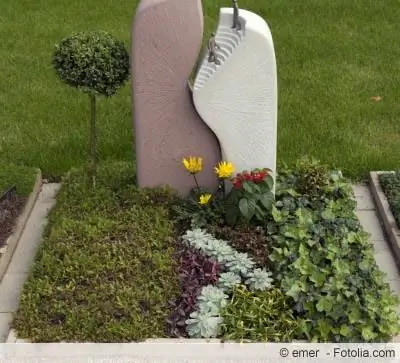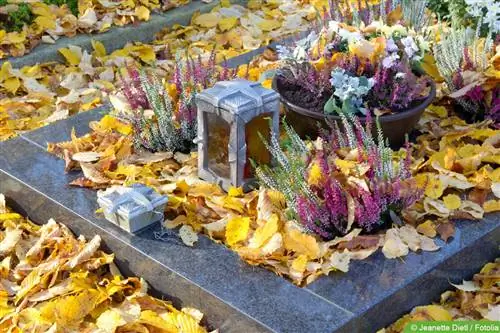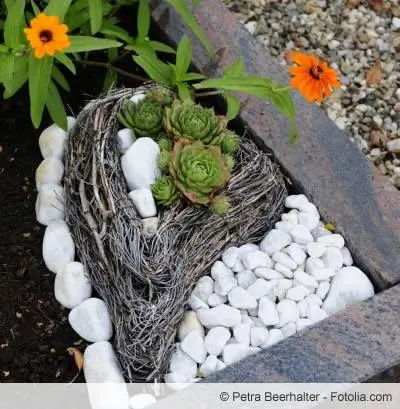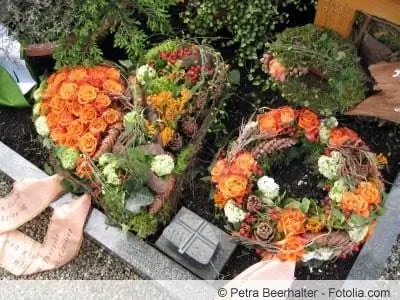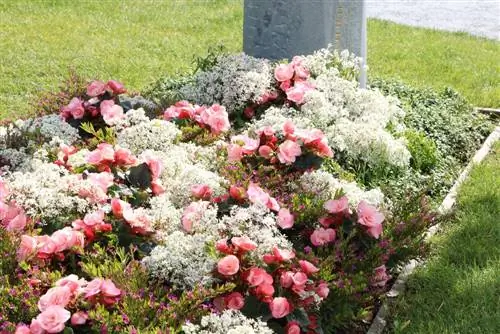- Author admin [email protected].
- Public 2023-12-17 03:39.
- Last modified 2025-01-24 12:45.
In modern grave design, new approaches are being taken these days that clearly stand out from the traditional design elements. While a homogeneous appearance used to be the rule, asymmetrical lines and unusual plant varieties are now in demand. In addition, most people no longer have enough time to often take care of the grave and its care. Easy-care, densely growing and evergreen plant varieties are therefore becoming increasingly popular, in combination with gravel, grave bowls and natural stones. In this way, annoying weeds have no chance.
Modern grave design
Modern grave design is defined by a combination of different and varied design elements. In traditional grave design, the decorative value was the top priority, although the maintenance effort was relatively high. The modern version is about pure design and ease of care. In the center of a grave there is usually a gravestone; traditionally, shaped and polished stones were used for this. Nowadays, this gravestone is replaced by sculptures, rough natural stones, metal grave crosses and grave pillars, which give the grave a modern touch. The usual border of the grave, made of the same material as the gravestone, is being replaced in many places by the use of plants:
- Rely on natural and flowing components
- Asymmetrical arrangements on the grave area are modern
- Place gravestones and grave crosses in the middle of the grave instead of at the end
- Large natural stones create islands of peace in the grave area
- Replace the stone grave surround with small and evergreen hedge plants
- Instead of uniform, it is better to combine different types of stone together
- Special effects are achieved through the unusual structures of the individual elements
- Height differences in the plants and the stones
- Mix of flowers and bushes
- Planted grave bowls that can be adapted to the season
Planning
In order for modern grave design to be successful, it should be planned well before work begins. In this context, many factors must be taken into account, the most important of which are the established rules of the respective cemetery regulations. Changes made subsequently involve a significant amount of work and additional costs. In addition, the grave should also fit the deceased to honor their last wishes. The following criteria must be taken into account:
- Check the cemetery regulations
- Explore the orientation, size and location of the tomb
- Note the design of the nearby graves
- Determine the format and color of the gravesite
- Set the size and shape of the border
- Explore the texture and weight of the stones
- Exploring soil quality and lighting conditions
- Free time for care use and record existing budget
- Create sketches true to scale, initially with various ideas for the design
Grave design with gravel
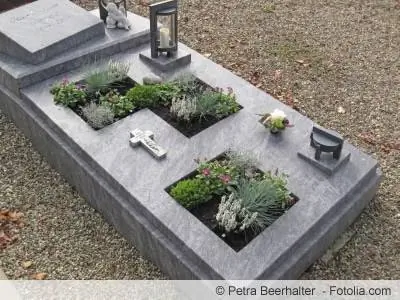
Gravel is increasingly replacing the earth on graves as this material is easier to handle and requires less maintenance. White-colored pebbles in particular look elegant and ideally highlight the colorful colors of the selected plants. The big advantage of gravel is that it makes life difficult for weeds and moss because the oxygen and light supply is interrupted. Specialist retailers offer a wide range of different types of gravel, which can be perfectly adapted to the respective grave site:
- Pebbles are available in white, grey, colorfully colored and in subtle natural tones
- Dig up the desired area about 20-25 cm deep
- Remove all dead matter (weeds and roots) and stones
- Lay robust fleece under the gravel to prevent weeds from growing
- Apply gravel all over the desired areas
- Leave recesses for the gravestone, plants, grave bowls and grave lamps
- Pebbles can be laid out into interesting shapes and patterns
- Make shapes with larger stones, e.g. B. circles or diamonds, and fill with gravel
- Order a sufficient amount of gravel, use the calculator to determine your requirements at a specialist retailer
- Lay gravel around the grave to keep out weeds
Grave design with plants
The ground cover plants are the classics among grave plants; there is a wide range of varieties to choose from, with ivy and heather still very popular. There are also many, mostly relatively unknown, plants for modern grave design that give the grave a new ambience. Many cemeteries are designed as a kind of park, so the graves are often shaded under tree-lined avenues. Therefore, when buying new plants, you should always pay attention to their location requirements. Evergreen and late-flowering plants decorate the grave with colorful accents even in winter; a mixture of early and late bloomers is ideal. When the late flowering period is over, the other plants on the grave begin to bloom again in spring and summer. In this way, the grave shines with great flowers all year round. Seasonal and usually uncomplicated flowering plants provide a nice variety and fresh color accents. In addition, plants with a symbolic character are very popular when planting graves, as they not only express the feelings of the mourners, but also describe the character traits of the dead person. For larger graves, trees and bushes can also be used to design the grave and can be pulled and cut into the desired shape:
- The grave looks great all year round with evergreen ground cover plants
- Ground to full shade compatible ground cover: fatman, ivy, sedum, hazelroot, evergreen honeysuckle, millbeckia, spindle bush, star moss, ysander, cotoneaster
- Optimal for the winter: Red carpet berry, maximum 15 cm high, red flowers from October to May
- Ground cover for sunny locations: lilac cushions, prickly nuts, low-growing roses, thyme, juniper, woolly zest
- Plants for moist soil conditions: Jacob's ladder, pennywort, checkerboard flower, Siberian iris, swamp iris, daylily
- Seasonal flowering plants: cyclamen, begonias, chrysanthemums, autumn asters, petunias, snow heather, pansies, marigolds, violets
- Symbolic plants: Memorial, Hanging Pussy Willow, Tree of Life 'Thuja', Lily, Cowslip, Bleeding Heart, Forget-me-not
- Trees and shrubs: Blue-gray dwarf cypress, blue dwarf juniper, boxwood, Japanese maple, Japanese azalea, columnar yew and all evergreen berry bushes
- A mix of unusual plant varieties gives the grave a modern ambience
Tip:
When arranging the plants, leave some gaps and decorate them with grave bowls and grave lights. This loosens up the overall picture and creates a harmonious impression.
Care & Maintenance
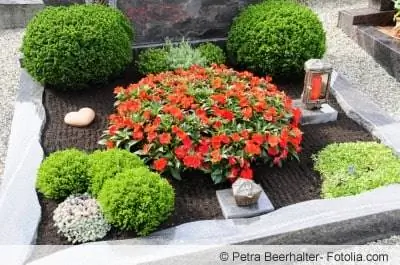
When planting, it is important to ensure that the selected varieties are somewhat drought-tolerant, so that longer breaks in care and sunny locations are better tolerated. In addition, the grave soil in most cemeteries is rather sandy and tends to be dry. Flowers need to be watered adequately during dry weather so that the blooms can last for a long time, which is why flower diggers are particularly maintenance-intensive. If you don't have much time, you should choose evergreen and undemanding plants:
- Densely growing ground cover and laid gravel prevent unsightly weed growth
- Ivy grows quickly and grows beyond all boundaries, remember to cut back in time
- If you have little time for care, colored bark mulch is an easy-care alternative to ground cover
- Water and care for flowering plants regularly
- Avoid waterlogging at all costs
- Carefully remove rotten flowers and other plant parts
- Remove dry leaves, this work is particularly important in autumn
- Make the grave area storm-proof, must be able to withstand strong gusts of wind
- Anchor gravestones, grave bowls and grave lamps securely and securely from theft
Tip:
To make maintenance of the grave site easier, stepping stones can be laid on the grave area, which enable easier access to all areas.
Conclusion
In modern grave design, new accents are set that differ greatly from the traditional design elements. Instead of uniform and symmetrical shapes, asymmetrical lines are now used in gravesites. The gravestone no longer has to be at the end of the grave and be perfectly carved, but can be placed in the middle and made of unprocessed natural stone. The use of gravel to create the resting place reduces the maintenance effort and suppresses the growth of weeds in the long term. In addition, elegant structures can be created using pebbles in different colors, shapes and sizes. When planting, the focus is also on reducing the amount of care required; undemanding and robust flowers, trees and shrubs are in demand. Evergreen and winter-hardy plants make the grave appear attractive all year round and also forgive a longer break in care.

